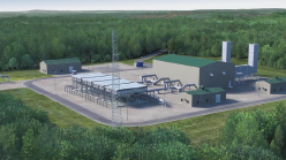In January 1999, the INGAA Foundation published Pipeline and Storage Infrastructure for a 30 Tcf Market. The report was the first in a series of studies examining the opportunities and challenges facing the natural gas industry in serving the growing natural gas market. The 1999 study focused on the pipeline and storage infrastructure needed to serve a U.S. gas market that grows to 30 Tcf by 2010 or shortly thereafter. The study found that serving a 30 Tcf market was economically feasible. However, the study also concluded that all segments of the gas industry would face challenges in serving a growing market.
Since the publication of the first study, a number of important events have occurred in gas markets. These include:
- The expected wave of new gas-fired generation that was projected to drive much of the growth in gas demand has begun to come "on-line" – with limited amounts of alternative fuel capability (oil backup),
- Natural gas prices experienced an unprecedented price surge beginning in the summer of 2000 and continuing through the first half of 2001,
- The U.S. economy experienced a significant slowdown beginning in the third quarter of 2000 that is likely to continue into 2002,
- The Bush Administration submitted a "National Energy Policy" to the Nation and Congress that emphasizes the need for increased domestic energy production including gas, oil, coal and nuclear energy, additional energy infrastructure, and increased energy efficiency,
- The terrorist attack of September 11, 2001 created a security imperative for the natural gas industry and all "human needs" industries throughout the United States and the developed world,
- Equity prices and bond ratings for a number of energy companies experienced substantial pressure in the wake of the filing for "Chapter 11" bankruptcy protection by Enron. This has resulted in reductions of capital expenditures for both natural gas infrastructure and power generation.
Of these events, two have the potential to accelerate the gas industry’s drive towards a 30 Tcf market. However, the gas price "spike" and a slowing economy both have the potential to retard gas consumption growth over the next few years. Nevertheless, most current gas demand forecasts project that natural gas demand will reach 30 Tcf shortly after 2010.
The impact of the most recent events has yet to be fully evaluated in most projections of future energy markets. The terrorist attack and the resulting emphasis on security have increased the importance of secure design and operation of natural gas transmission and storage facilities and may increase the cost of providing service. Finally, the impact of the pressure on equity prices and ability to generate capital will increase the total cost of debt-financed projects for at least the near-term. In the intermediate and long-term, the impact remains unclear.
Market Growth
Growth in gas consumption for power generation will be the principal driver towards a 30 Tcf market. However, all demand sectors will exhibit growth. Substantial growth will occur in all regions of the country, with the largest increases expected in the South Atlantic states, Florida and the Mid-Atlantic states. Regions that have not had historically large amounts of gas demand, such as the West North Central and Mountain regions will have large amounts of growth in percentage terms.
Exhibit ES-1
U.S. Natural Gas Demand
(Bcf per Year)
2000 2005 2010 2015 % change
Residential 5,084 5,268 5,588 5,787 13.8%
Commercial 3,298 3,387 3,696 3,824 15.9%
Industrial 8,736 9,258 9,997 10,545 20.7%
Power Generation 4,180 6,068 7,820 8,605 105.9%
Other 2,023 2,331 2,483 2,570 27.0%
Total 23,321 26,312 29,584 31,330 34.3%
Pipeline and Storage Capital Requirements
The analysis estimates that the natural gas industry will require $67.9 billion (in constant 2001 dollars) of investment in pipeline transmission and storage infrastructure from 2001 to 2015 in the United States and Canada 1 . This estimate of industry capital requirements includes the cost of new transmission and storage facilities and routine replacement of existing facilities, but excludes the cost of gathering lines and distribution investment, which were outside the scope of this analysis.
Transmission Expenditures
The analysis estimates that the gas pipeline industry must invest $47.7 billion (in constant 2001 dollars) in U.S. gas transmission capacity from 2001 through 2015, an average of $3.2 billion per year. A little more than 80 percent of the investment will go toward new pipeline capacity with the remainder required to replace and refurbish existing pipeline and compression facilities. The required investment is larger than the estimate published in the 1999 report for a number of reasons including:
- The estimate includes the U.S. portion of an Alaskan Gas Pipeline (assumed to utilize the Alaskan Highway route), and
- Additional "peak-day" transmission capacity is needed to serve power generation gas demand. With substantially less dual-fuel capacity available for seasonal fuel switching, power generation gas consumption is projected to add incremental consumption to winter season peak loads.
The industry also will need to invest $16.8 billion (U.S.) in gas transmission facilities in Canada, an annual average of $1.1 billion expressed in 2001 dollars. The investment is required to allow increased deliveries from Eastern Canada and existing production areas in Alberta and British Columbia as well as Arctic gas supplies from Alaska and the MacKenzie Delta.
Storage Capacity Expenditures
Total U.S. gas storage expenditures during the same period are projected to total $2.8 billion (in 2001 dollars), an average of nearly $190 million per year. An additional $400 million investment – approximately $30 million per year – in storage facilities is required in Canada to serve incremental load requirements. Nearly 70 percent of the capacity additions are required in the Northeast and Eastern Canada to meet growing peak-month requirements in the temperature-sensitive markets of New England, the Northeast and Eastern Canada. In total, the market requires an additional 334 Bcf of working gas capacity with approximately 75 percent of the additions required before 2010.
Industry Challenges
The analysis performed for this study concludes that market fundamentals exist that can lead to a 30 Tcf natural gas market in the 2010 to 2015 timeframe. However, gas market growth will require that the industry, policy markets, and capital markets develop approaches to address a number of critical challenges.
- The pipeline and storage investments must attract more than $67 billion in capital expenditures in the United States and Canada. To accomplish this, pipeline and storage investments must realize a rate of return that is competitive with other investment alternatives in other sectors and within the corporate family of existing pipeline companies. In addition, pipeline and storage infrastructure must have access to land for pipeline and storage construction through a regulatory policy that recognizes the importance of gas infrastructure development to the economic vitality and security of the United States.
- The gas supply sector must grow U.S. gas production (including Alaskan gas) from 19.1 Tcf in 2000 to 25.6 Tcf in 2015. Lower-48 state gas production must increase from 18.7 Tcf to 23.5 Tcf over the same period. To meet this challenge, the supply sector must realize adequate rates of return to attract the capital needed to support production growth, gain access to public lands for gas and oil exploration and production, continue to advance exploration and production technology, and be subject to rational royalty and environmental policy.
- End-use markets must see competitive prices for delivered gas supplies. To accomplish this, the industry must be allowed to be innovative in the methods and procedures that it employs to meet legitimate public policy objectives rather than be subject to prescriptive regulations. In addition, environmental control requirements for end-use technologies should be fuel neutral and should not overly penalize natural gas technologies measured on an output basis.
- The market for gas transportation and storage services must augment the existing customer base with entities willing to make the financial commitment to expansion by signing a significant quantity of the longer-term contracts that are necessary to support new construction projects. The customer base should include a mix of producers, LDCs, power generators, and energy marketers. While there have been some increases in contracting after the winter of 2000-2001, the question remains, who will hold the long-term contracts needed to support pipeline and storage expansion?
Failure to meet these challenges could delay or cancel needed pipeline and storage construction, constrain the development of gas supplies, and raise energy prices to U.S. consumers. In the absence of adequate gas supply at competitive prices, prospective gas users would seek other fuels that could increase air pollution or increase the nation’s reliance on energy imports from less stable regions of the world. Equipment choices made by end-users over the next several years will remain in service for decades. Therefore, delays in market development would result in a loss of gas load, additional reliance on imported energy for years and have significant air quality impacts 3 for years to come.





